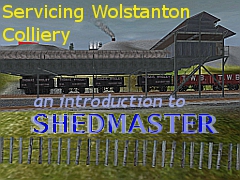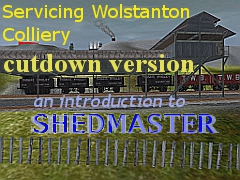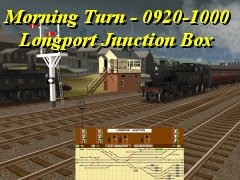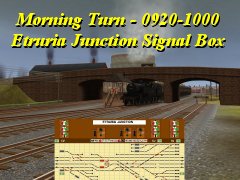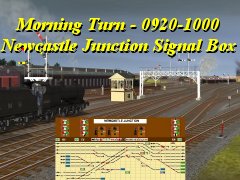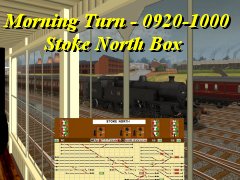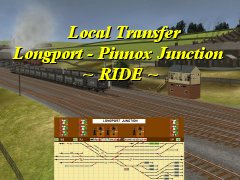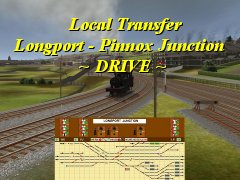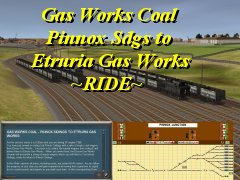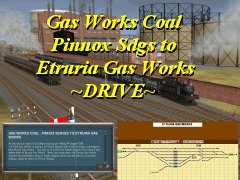A number of sessions are included for the route as well as ones specific to the Shelton Bar industrial area. Some of these are standard sessions for you to drive and the 'ride' versions are where the AI driver takes control and you can watch to see how it is done before replacing the driver and having a go yourself, or you could just go along for the trip and enjoy the scenery.
This page also lists the sessions which are included for use with the 'Shed Master' and Signal Box' rules. These rules each have their own page and further information on them can be found there.
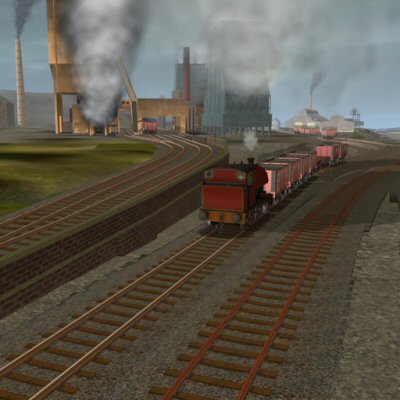
Birchenwood Shunt - Drive
In this 30 minute Drive session you are in charge of the large Birchenwood shunting engine which is responsible for exchange traffic with the LMS at Kidsgrove. At the start of the session the LMS shunting engine has left a consist of empty brick flats and loaded sand and coal wagons which you will push through the tunnel and as far as Summit Junction, the access to Birchenwood for incoming traffic. After shunting operations within Birchenwood works you will ultimately bring some coal empties, full coke and brick wagons back down to Kidsgrove.
Switching of points is done automatically in this session, but there are some matters which need to be taken into account. These are explained on screen and particular attention needs to be paid to positioning of your engine, not exceeding the speed limit of 15mph and keeping control of heavy consists on steep gradients.
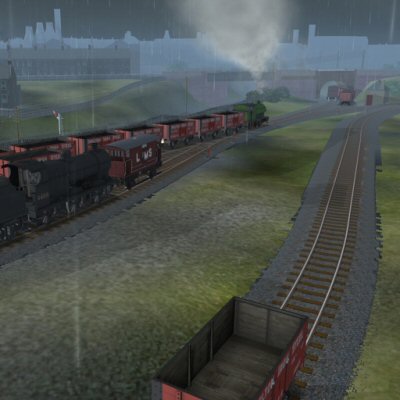
Deep Pit Circle - Ride
The two collieries on the Loop Line south of Tunstall were serviced several times a day by a circular trip that started and finished at Longport. It includied two reversals, travelled via Tunstall, shunted at either colliery, and completed the trip via Hanley and Etruria. This trip with an LMS Fowler 4F 0-6-0 visits the exchange sidings of the Hanley Deep Pit and the working is complicated because the link line from the sidings is on the up side of the line but it only directly connects to the down line. Moreover the sidings themselves are short, so the incoming train of empties has to be split at Cobridge and worked on to the colliery in two separate sections. Fitting this service in without disrupting the frequent passenger trains is difficult especially as this particular service is working at the commencement of the evening peak period.
The train of full coal wagons is taken up the Loop Line and then reverses into Etruria Up Yard. The 4F then takes two guards' vans from Etruria Down Yard to Longport Junction.
The session operates automatically, features 16 locomotives and lasts about 90 minutes.
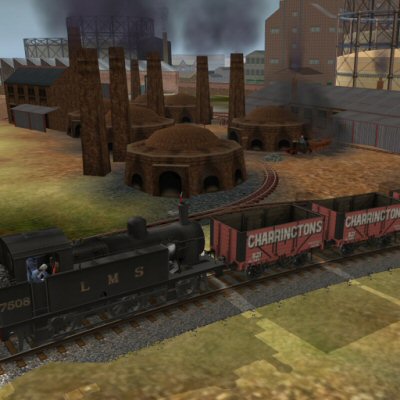
Etruria Gas & Canal Tileries
Stoke mpd had about a dozen Class 3F 0-6-0T locomotives for shunting work at the yards in the vicinity, plus short trip workings. This session starts at Cockshute Sidings and covers an hour of a day's work of one of these shunters which has been detailed for a return trip to deliver coal to the nearby Etruria gas works. The trip also includes servicing the adjacent Canal Tileries with coal and sand plus the collection of bricks. The siding servicing the Tileries is steep and has no run round facility. It is necessary to split the train of wagons at the level crossing to enable the engine to haul the heavy sand wagons to the top of the siding. There are three Simplex diesel shunters operating at Canal Tileries. They run around servicing the clay pit, the mix and pressing sheds, the beehive kilns and the despatch shed.

Grange Branch and Burslem Foundry
The Grange Branch at the small goods yard at Grange Wharf but its principal purpose had been to service the nearby Grange Colliery. A subsequent connection to the Shelton steelworks made the branch very busy even after the colliery ceased coal winding by 1918. This 30 minute session follows the Grange Branch engine on a return trip to Grange Wharf to shunt the goods shed and to replenish coke and scrap metal staithes. You will notice the lorries playing 'chicken' with the rail traffic whilst they collect coke and scrap for Burslem Foundry. You can hop into the cab of one of them for a trip through the streets of Burslem. Vehicle seat belts were a product of the future but you will feel the need of them from time to time.

Loop Line Locals
The Loop Line passenger service was frequent throughout the day and during morning and evening 'rush hours' precluded all other types of traffic movements. This 1 hour session follows a stopping passenger train from Stoke on its return trip to Kidsgrove.

Loop Line Locals Drive
The Loop Line passenger service was frequent throughout the day and during morning and evening 'rush hours' precluded all other types of traffic movements. In this 1 hour session you will drive a stopping passenger train from Stoke on its return trip to Kidsgrove. You will have to keep to the schedule and penalties apply for late running.
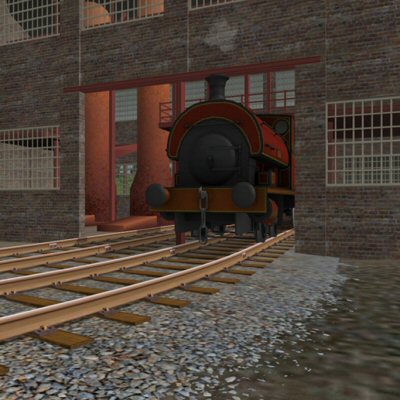
Maryhill and Albion
Maryhill Colliery suffered a disastrous inundation in 1930 and activity was then limited to the footrails (drifts) which accessed coal near the surface. By 1938 the available coal was becoming exhausted so there was not much work for the colliery shunter. Its duties were expanded somewhat by the Albion iron foundry and this 45 minute session includes the shunting jobs that the two concerns required.
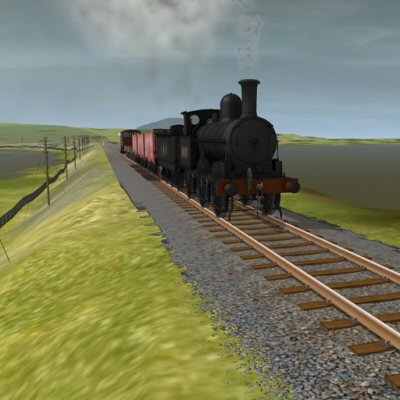
Newfields Trip
The short Newfields Branch served a goods wharf and left the Loop Line on the north side of Tunstall by means of a zig-zag junction. There were severe weight restrictions and only very light engines could travel over it. Stoke shed had a couple of Victorian era 'Cauliflowers' for this purpose and this 1 hour session follows a return trip from Longport Junction which includes some shunting at Tunstall and Newfields. The side trip to Newchapel & Goldenhill is only necessary to ensure that the correct train formation is maintained between Tunstall and Newfield Junction.
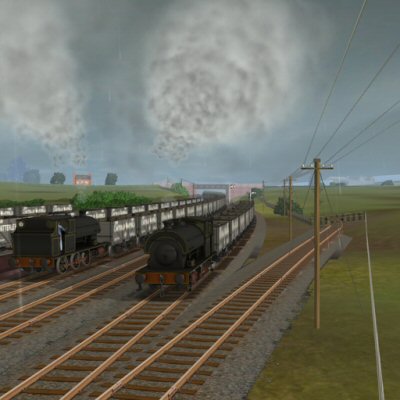
Pinnox Brownhills Trip
Chatterley Whitfield colliery was the largest coal mine in the UK in the 1930s with an output that exceeded 1 million tons per annum. A large part of the mine's output was destined for the Cheshire salt fields or for export via Liverpool and at first this entailed a roundabout journey to the south via Stoke. The colliery then built the Pinnox Mineral Railway which cut the journey distance and reduced the transport costs. The coal was thereafter transported to Pinnox Junction where it was handed over to the LMS.
The Pinnox Mineral Railway also serviced three coal wharves which handled land sales to local industries and coal merchants. This session follows the Pinnox shunter on a morning trip delivering full wagons to Brownhills coal wharf and returning with empties. The trip takes less than half an hour. Because of the heavy loads and steep gradients great care has to be taken to avoid exceeding the speed limit or getting out of control. All trains must stop before proceeding over the ungated Scotia Road level crossing at Pinnox.
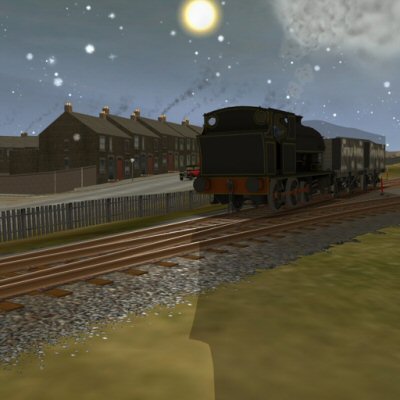
Pinnox Greenhead Trip
Chatterley Whitfield colliery was the largest coal mine in the UK in the 1930s with an output that exceeded 1 million tons per annum. A large part of the mine's output was destined for the Cheshire salt fields or for export via Liverpool and this entailed a roundabout journey to the south via Stoke. The colliery built the Pinnox Mineral Railway which cut the journey distance and reduced the transport costs. The coal was then transported to Pinnox Junction where it was handed over to the LMS.
The Pinnox Mineral Railway also serviced three coal wharves which handled land sales to local industries and coal merchants. This session follows the Pinnox shunter on a morning trip delivering full wagons to Greenhead coal wharf and returning with empties. The trip takes just over half an hour. Because of the heavy loads and steep gradients great care has to be taken to avoid exceeding the speed limit or getting out of control. All trains must stop before proceeding over the ungated Scotia Road level crossing at Pinnox.
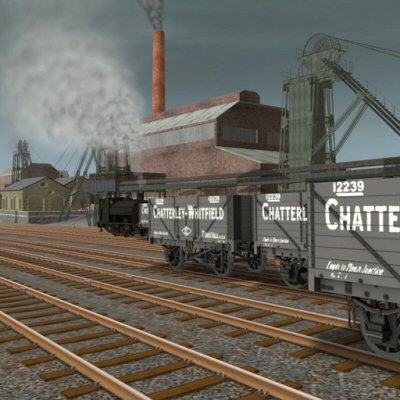
Pinnox Mineral Railway
This session shows the traffic involved in the continuous supply of empties to Chatterley Whitfield Colliery and the despatch of full coal trucks to their destinations. It covers the yards at Whitfield, Pinnox and Longport. Three locomotives' activities are featured and the session completes within an hour.
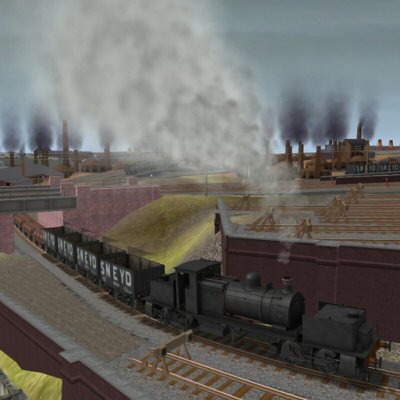
Sneyd Coal & Brick
Sneyd Colliery and Brickworks straddled the Loop Line. It was home to a Beyer Garratt locomotive, one of only four articulated engines used at industrial locations in the UK. This 2 hour session follows the Garratt all over the extensive site as it collects and distributes incoming wagons, deals with the internal traffic and prepares outgoing consists for the Loop Line. Three external goods trains visit Sneyd during this period.
There is also a narrow gauge rail system that covers that part of the brickworks which is to the east of the Loop Line. Two petrol driven engines are in continuous use dealing with the sand, clay, coal and brick materials.
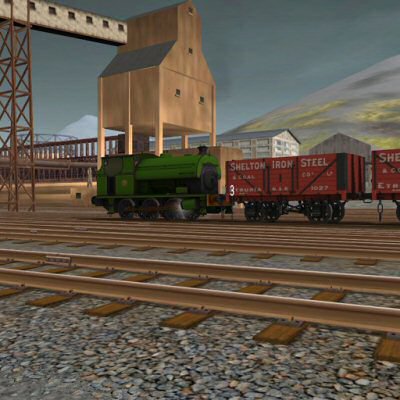
Shelton Bar1 - Pit to Oven
Shelton Bar was a truly integrated iron and steelworks in that it sourced at least part of its iron ore and all its coal needs from local pits. Indeed one of them, Racecourse Colliery was on the steelworks site. In this 30 minute session you will drive a works shunter from the engine shed to the coke ovens where you will collect empty wagons which you will take on two return trips, one to Hanley Deep Pit and the second one to Racecourse Colliery. At both mines you will leave the empties and collect full wagons of coal which have been filled via the mines' gravity filling systems.
You will be setting your own road in this session and there are help screens to assist you with this.
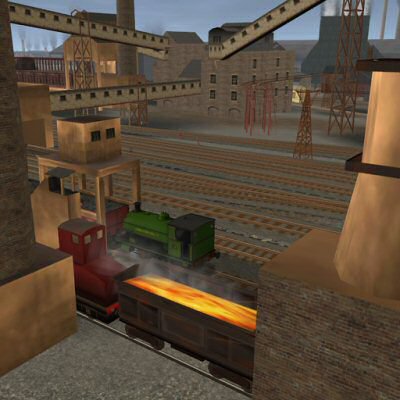
Shelton Bar2 - Coke Oven Products
The coke ovens shunter dealt with incoming coal from off site collieries, the loading of coke and transferring the full wagons to North Yard, and the loading of coke ovens by products from the liquids loader and the fertilizer plant. This one hour long session deals with all these duties.
You will be setting your own road in this session and there are help screens to assist you with this.
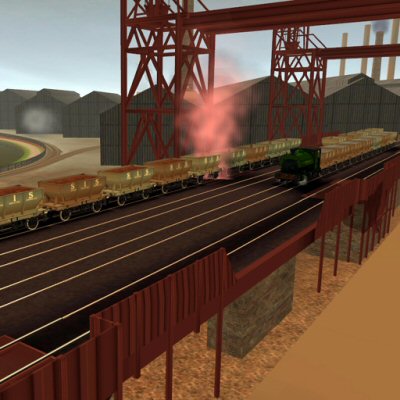
Shelton Bar3 - Blast Furnace Chargeside - Ride
The iron ore, coke and limestone which made up the burden for the Etruria blast furnaces were kept in bins that were replenished from wagons brought down from North Yard. This session follows the locomotive assigned for charging duties. Because of the layout at North Yard a second locomotive was used to position the full wagons and remove the empty ones at intermediate sidings which avoided having to run round every consist twice.
The session takes 45 minutes to complete and no input is required.
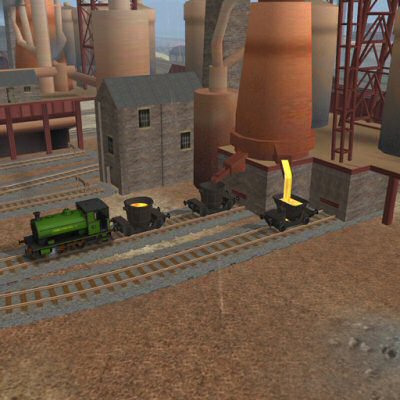
Shelton Bar4 - Hot Metal and Slag
The blast furnaces at Shelton Bar produced not only hot metal for the open hearth furnaces in the adjoining steelmaking plant but also pig iron which was sent to the John Summers steelworks at Hawarden Bridge.
The session is concerned with the blast furnace front side shunter whose duties encompassed transfer of the hot metal and disposal of the slag on the extensive tip. This is an active session; although it will take about 45 minutes to service all three blast furnaces you can choose to complete only part of it.
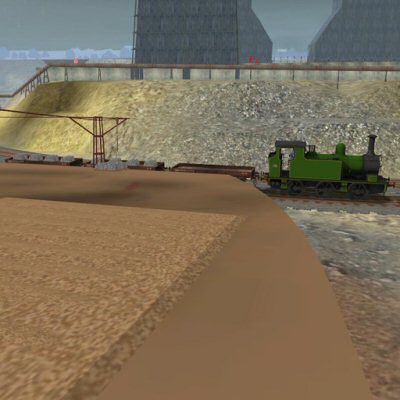
Shelton Bar5 - Pig Iron
The blast furnaces at Shelton Bar produced not only hot metal for the open hearth furnaces in the adjoining steelmaking plant but also pig iron which was sent to the John Summers steelworks at Hawarden Bridge.
The 35 minute session commences in the North Yard where one of the yard shunters couples to some flat wagons and takes them to the No1 blast furnace for loading at the pig iron wharf. The short headshunt requires the consist of 9 wagons to be split into rafts of three prior to loading.
The full wagons are returned to North Yard and then made up into a train for hand over to the LMS Grange Branch locomotive to transfer to Grange Yard on the first part of its journey to North Wales.
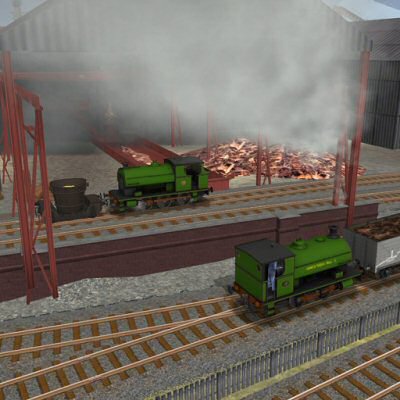
Shelton Bar6 - OH and Bar
The shunt session at the steelmaking and bar mill is of 1 hour duration. The duties include delivery of coal to the gas producers for firing the open hearth furnaces and delivery of scrap metal which makes up half the charge of metal for conversion to steel. The final duty is the loading of finished steel bars for despatch to customers.
The blast furnace front side locomotive is also working in the area delivering hot metal. That duty has priority so you must not delay its passage.
Take care when delivering the coal and the scrap, the consists are heavy and you will be operating on steep downgrades. It takes some distance to stop the train.
